by Deborah Dimmett, The University of Arizona
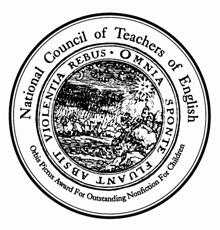 >The Orbis Pictus Awards, established in 1989, commemorates the work of Johannes Amos Comenius, whose work included the first nonfiction book for children, Orbis Pictus—The World in Pictures (1657). Each year, NCTE gives one award for a book representing the best of children’s nonfiction for that year along with five honor books and eight recommended books can also be recognized.
>The Orbis Pictus Awards, established in 1989, commemorates the work of Johannes Amos Comenius, whose work included the first nonfiction book for children, Orbis Pictus—The World in Pictures (1657). Each year, NCTE gives one award for a book representing the best of children’s nonfiction for that year along with five honor books and eight recommended books can also be recognized.
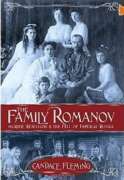 The Family Romanov: Murder, Rebellion & the Fall of Imperial Russia by Candace Fleming was the standout. This book (for 12 years and up) is an amazing and complex story about the family; however, Fleming superbly provides the context for readers who are unfamiliar with the history. The story is a history of Czar Nicholas II who stepped into his father’s place but with little preparation to do so. The surprises throughout the story help us to understand how years of oppression and deprivation created a point in history in which the population would embrace revolutionary fervor. Secretive deaths and burials became a part of the legend of the Romanov family with many of the mysteries solved decades later. The story is rich with details and gives us an introduction to another very important historical figure—Vladmir Lenin.
The Family Romanov: Murder, Rebellion & the Fall of Imperial Russia by Candace Fleming was the standout. This book (for 12 years and up) is an amazing and complex story about the family; however, Fleming superbly provides the context for readers who are unfamiliar with the history. The story is a history of Czar Nicholas II who stepped into his father’s place but with little preparation to do so. The surprises throughout the story help us to understand how years of oppression and deprivation created a point in history in which the population would embrace revolutionary fervor. Secretive deaths and burials became a part of the legend of the Romanov family with many of the mysteries solved decades later. The story is rich with details and gives us an introduction to another very important historical figure—Vladmir Lenin.
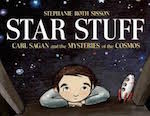 The five honor books selected include Star Stuff: Carl Sagan and the Mysteries of the Cosmos (ages 4-8) written and illustrated by Stephanie Roth Sisson. The book is a playful, but accurate, account of Carl Sagan’s life from the time he was a young boy when he began to ask questions about his environment and imagined extraterrestrial life and space travel. Sisson demonstrates how his imagination and persistence about the cosmos allowed him to realize many accomplishments.
The five honor books selected include Star Stuff: Carl Sagan and the Mysteries of the Cosmos (ages 4-8) written and illustrated by Stephanie Roth Sisson. The book is a playful, but accurate, account of Carl Sagan’s life from the time he was a young boy when he began to ask questions about his environment and imagined extraterrestrial life and space travel. Sisson demonstrates how his imagination and persistence about the cosmos allowed him to realize many accomplishments.
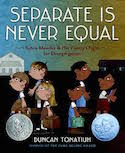 Separate Is Never Equal: Sylvia Mendez and Her Family’s Fight for Desegregation (ages 6-9) written and illustrated by Duncan Tonatiuh is the story about how the Mendez family fought for the end of school discrimination against Mexican-American children in Brown v. Board of Education. The story depicts Sylvia Mendez, the daughter of the parents who brought suit in California. Through Sylvia’s recollections of her young life, we learn about the civil rights case and the difficulties of growing up in an era and going to school in an era where her parents were fighting not only for her civil rights but for those of all children who had previously been excluded from predominantly Caucasian schools.
Separate Is Never Equal: Sylvia Mendez and Her Family’s Fight for Desegregation (ages 6-9) written and illustrated by Duncan Tonatiuh is the story about how the Mendez family fought for the end of school discrimination against Mexican-American children in Brown v. Board of Education. The story depicts Sylvia Mendez, the daughter of the parents who brought suit in California. Through Sylvia’s recollections of her young life, we learn about the civil rights case and the difficulties of growing up in an era and going to school in an era where her parents were fighting not only for her civil rights but for those of all children who had previously been excluded from predominantly Caucasian schools.
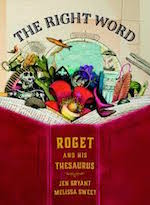 The Right Word: Roget and His Thesaurus (ages 6-10), written by Jen Bryant and illustrated by Melissa Sweet, is a splendidly told biography of Peter Mark Roget. The biography begins with Roget as a shy young boy, born in London in 1779, who endured a series of setbacks throughout his life. Among the first was the death of his father and his mother’s instability. Peter was able to find solace in books and began to classify his knowledge and experiences, composing this first book of lists when he was only 8 years old. His interests expanded to taxonomy of medicine and botany as he continued o work on a book of word classifications. The Thesaurus, published in 1852, became one of his major contributions.
The Right Word: Roget and His Thesaurus (ages 6-10), written by Jen Bryant and illustrated by Melissa Sweet, is a splendidly told biography of Peter Mark Roget. The biography begins with Roget as a shy young boy, born in London in 1779, who endured a series of setbacks throughout his life. Among the first was the death of his father and his mother’s instability. Peter was able to find solace in books and began to classify his knowledge and experiences, composing this first book of lists when he was only 8 years old. His interests expanded to taxonomy of medicine and botany as he continued o work on a book of word classifications. The Thesaurus, published in 1852, became one of his major contributions.
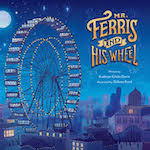 Mr. Ferris and His Wheel (ages 5-8) written by Gibbs Davis and illustrated by Gilbert Ford, is the story of the how George Washington Gale Ferris, Jr., a mechanical engineer, invented the Ferris wheel. The story demonstrates his creativity and perseverance to creating a structure for the delight of all fair goers. The Ferris wheel was introduced at the 1893 World’s Fair in Chicago where Mr. Ferris and his wheel were a hit—and continue to be.
Mr. Ferris and His Wheel (ages 5-8) written by Gibbs Davis and illustrated by Gilbert Ford, is the story of the how George Washington Gale Ferris, Jr., a mechanical engineer, invented the Ferris wheel. The story demonstrates his creativity and perseverance to creating a structure for the delight of all fair goers. The Ferris wheel was introduced at the 1893 World’s Fair in Chicago where Mr. Ferris and his wheel were a hit—and continue to be.
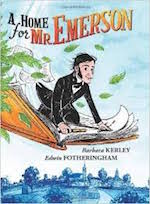 A Home for Mr. Emerson (ages 8-12), written by Barbara Kerley and illustrated by Edwin Fotheringham, is the biography of the 19th-century American philosopher Ralph Waldo Emerson. The book is not only about his life as a young boy growing up, but also about the philosophy that he embraced. When Emerson was a young boy, he delved into books to learn about the world and its mysteries. His favorite place was the cozy house he lived in until one day a terrible fire burned down his beloved home. Although he was deeply affected by this, it did not stop him from globe trotting across U.S. maps and diving into books for knowledge and nurture. One of his featured quotes is: “Every spirit builds a house, and beyond its house a world . . . Build therefore your own world.”
A Home for Mr. Emerson (ages 8-12), written by Barbara Kerley and illustrated by Edwin Fotheringham, is the biography of the 19th-century American philosopher Ralph Waldo Emerson. The book is not only about his life as a young boy growing up, but also about the philosophy that he embraced. When Emerson was a young boy, he delved into books to learn about the world and its mysteries. His favorite place was the cozy house he lived in until one day a terrible fire burned down his beloved home. Although he was deeply affected by this, it did not stop him from globe trotting across U.S. maps and diving into books for knowledge and nurture. One of his featured quotes is: “Every spirit builds a house, and beyond its house a world . . . Build therefore your own world.”
An excellent selection for this year’s Orbis Pictus Awards! Awards from previous years can also be found at the NCTE website.
Please visit wowlit.org to browse or search our growing database of books, to read one of our two on-line journals, or to learn more about our mission.
- Themes: Deborah Dimmett, Orbis Pictus
- Descriptors: Awards, WOW Currents
